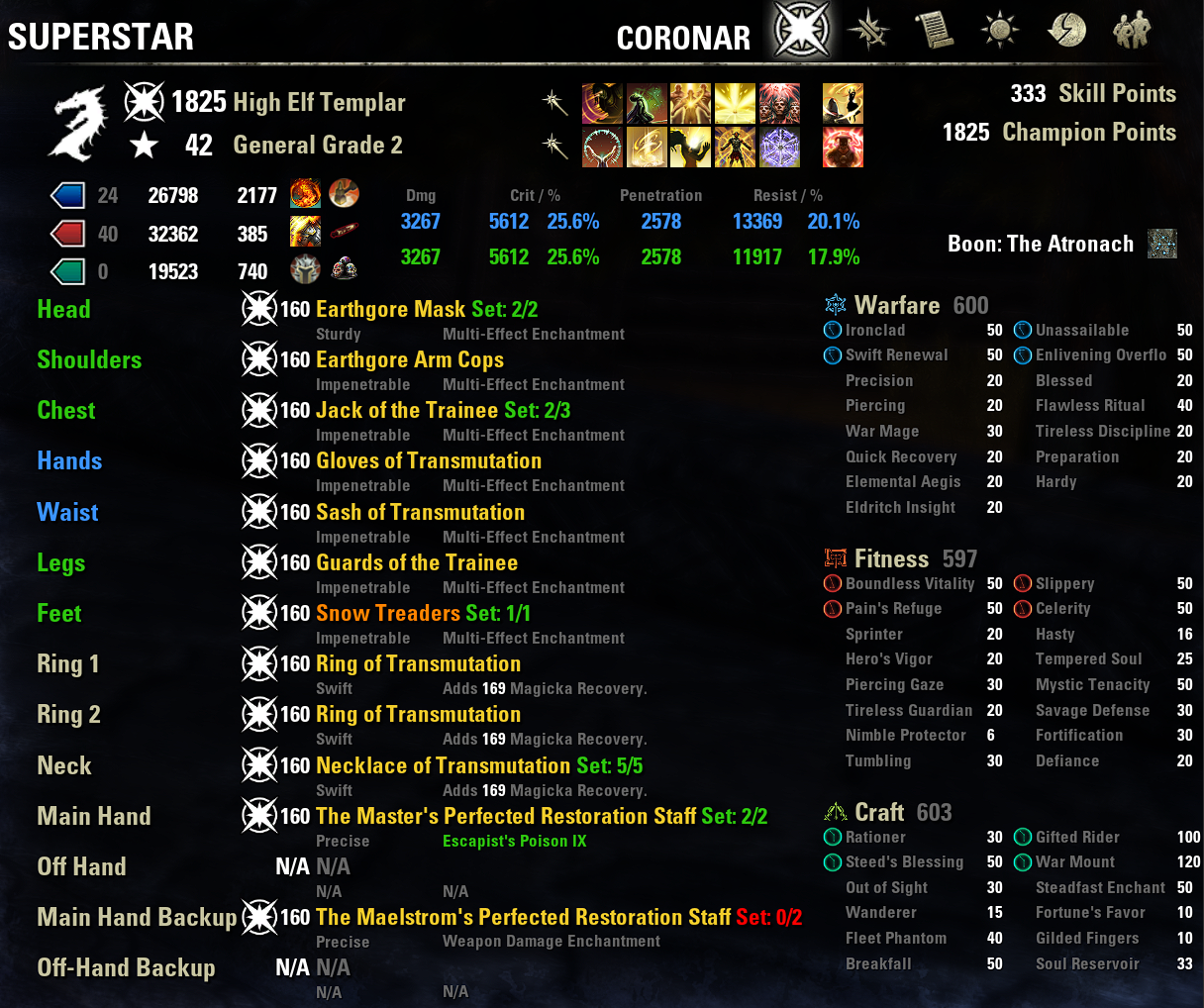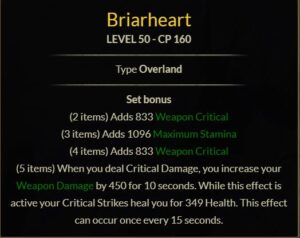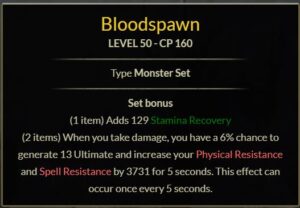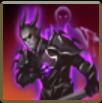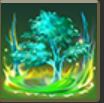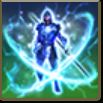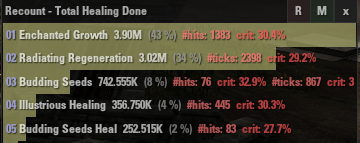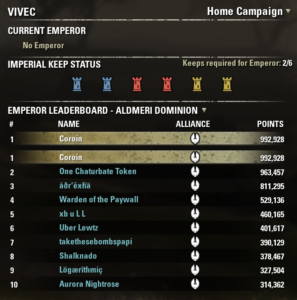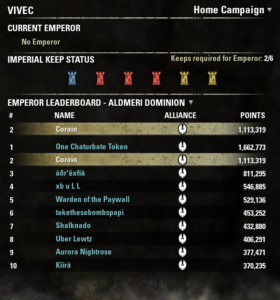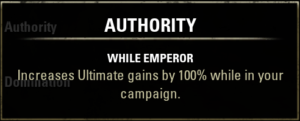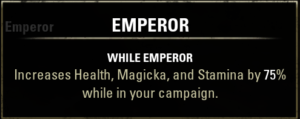Mayhem is upon us!
Updated: February 19, 2024
Some of you may be entering Cyrodiil for the first time. For others, it’s just another day with more mass killing of opponents. The intent of this guide is to provide a high level overview of what you should consider to ensure that you achieve your goals of making a lot of AP, getting a lot of reward boxes, and participating in as much mayhem as possible!
While you can enter Cyrodiil, collect quests, and make your way around surfing the zerg (following where the most players go), and you’ll probably make some good alliance points (AP), there are quite a few small things that you can do to ensure that you bring the most value to the faction and contribute well to fights – rather than being a hindrance to success.
During Mayhem, there are a lot of PvE players coming into Cyrodiil, and most of them haven’t read this guide. This means that they’re either very squishy and easy to kill, or they’re set up as tanks who will bring little to no value to fights. Most bombers will build for crit, and will be using builds that cause chain reactions of death such as Vicious Death, Plaguebreak, and the Occult Overload CP. If they get one single kill on someone squishy, almost everyone else around that person will also die. It’s very simple to say “don’t be squishy”, but doing so without being a tank can be challenging.
Build Recommendations:
- If you are experienced in PvP, this probably doesn’t apply to you – though I hope that it will help with any considerations or advice that you give others (notably new players).
- Read through the grouping framework at https://darkelves.com/zerg if you’re looking to group up and want to know how to build.
- Read through https://darkelves.com/builds if you want to know what kind of builds the min/max ball groups use. Note that if you’re not in a ball group where everyone is contributing to the group, then these builds can still be great, but you will need to get a source of major expedition for yourself (usually Race Against Time from the Psyjic tree).
- Be aware that most PvE builds don’t work well in PvP. You may do great damage, but you’re “VD fodder”.
- You should have approximately 35k health. Put all of your 64 character points into health, and then balance your gear enchants to achieve your other goals. If you can’t quite make 35k, do your best to keep your health as high as possible. In most builds, 64 points in health and tri-chants on your major pieces (head/chest/pants) should get you to about 33-34k, and you can get another 1k from red CP.
- The food/drink you use should give you health and the stat you need. I tend to prefer tri-food for health/mag/stam from Bewitched Sugar Skulls, but there are many viable options. Your priority (per above) should be reaching 35k health, then adding the stat you need most of. If you’re in a magicka-oriented build, having above 15k (even closer to 20k with tri-food) stamina is very helpful for breaking free, dodging, and the occasional blocking.
- All of your gear should have the Impenetrable trait to reduce critical damage. This is what will kill you most often (along with siege).
- In the red CP tree, take Celerity for movement speed, Slippery to help automatically break you free from hard crowd control (CC), and Pain’s Refuge to reduce incoming damage when you have negative effects on you (there will be many). This leaves one red CP of your choice, and I usually recommend Boundless Vitality for more health (if you’re under 35k), Bastion if you’re running shields in a group (Barrier, or a set such as Imperium or Combat Physician), or Spirit Mastery to resurrect your allies faster (especially if you’re playing a Templar).
- In the blue CP tree, take Ironclad, Unassailable, and Enduring Resolve to reduce incoming damage of direct, area, and over time. This leaves one blue CP of your choice, and I usually recommend Occult Overload so that when you get a kill, it can chain reaction kill others around your target.
- In the green CP tree, take Gifted Rider and Steed’s Blessing to increase your speed getting from keep to keep when you don’t have transit. This leaves two green CP of your choice, and I usually recommend Rationer and Liquid Efficiency to save gold on consumables, though during this even you do get additional resources from nodes, so faster harvesting and extra chance for more materials are viable.
- When picking the sets you want for your build, choose one set that is more defensive, and one that accomplishes your goal (more healing, more damage, or a proc). If one of those sets is crafted, make that the medium armour one. If one of those sets is light or heavy, use neck, rings, and one weapon – or neck, rings, and two body pieces so you can still maintain 5 medium. If one of those sets can be run on only one bar (such as Clever Alchemist or many other proc sets), then you can use a back bar arena weapon.
- Monster sets can bring enormous value, though if you will be using a Mythic item such as Snow Treaders or the speed ring (the two most common), then you’ll have to either break one of your 5-sets or your monster 2-set. Many solid builds include a monster 2-set, a Mythic 1-set, two arena weapons (master’s, maelstrom, asylum, or other), a 5-set, and two extra pieces (Trainee or one Trainee and one Druid are most common for the 2 extras). There is no absolutely wrong build, but there are many builds that are wrong for you to achieve your goals. One of my favourite solo builds is back bar Clever Alchemist, front bar Rallying Cry, Balorgh or Sellistrix monster set (depending on how you want to play), one Mythic, and one Trainee (for the 1-set health bonus).
- If your goal is to play defensively (defending keeps from attack), the Earthgore set for healing and purging ground effects is likely best, though the Sellistrix monster set is also a great choice if you’re doing some damage, as it will provide an area stun every 6 seconds.
- Use 5 medium armour. Most players who don’t die to area damage bomb chain reactions or Plaguebreak (per above) will die when they run out of stamina. Medium armour gives you more stamina sustain, more output, and lets you slot Shuffle or Elude. Both morphs give you Major Evasion which reduces area (and siege) damage by 20% (this is VERY important). Shuffle removes snares and lasts for 20 seconds, while Elude (the other morph) lasts 35 seconds and gives you Major Expedition when you take area damage. If you’re going to use Snow Treaders or have Race against Time slotted, pick Elude as it lasts longer.
- You must source your own Major Evasion skill. If you’re not in 5 medium, and not a NB who have their class skill (Mirage), then the Spectre’s Eye set on your back bar is a great option. If all else fails, you can use Quick Cloak from the dual wield skill line.
- If you’re not sure what build to use, A combination of Order’s Wrath (always active in 5 medium armour) with Wretched Vitality on one bar (for amazing resource regen) and an arena weapon on the other bar works very well. If you want to be more defensive or you don’t believe that you’ll have the reaction times needed to fight well, and just want to run around having fun, a great set to use is Imperium. It will put a shield on you and your allies when you take damage, gives some extra health, and can contribute to your team’s success (by you and your group members dying less).
Play / Style Recommendations:
- You will die. Probably a lot. There will be bombers, gankers, 1vPotatoers (most call them 1vX’ers, but as those players don’t actually fight similarly skilled players – otherwise they’d never win, this term is more accurate), and chain reactions of Plaguebreak and Vicious death that will leave huge piles of bodies. Death happens in PvP all the time, and you shouldn’t be discouraged. Every time you die, try to think about why you died, and if there was anything you could have done better – such as not stacking too close to other masses of players who haven’t read this guide and who aren’t following these recommendations. Note that when you die in range of a keep or resource, you contribute to the tick! Dying every 5 minutes (that’s how long it takes for you to be worth full AP again) is a good thing as if you win the fight, your team will get more AP!
- Use cross heals as much as you can. Echoing Vigor and Radiating Regeneration apply Heal over Time (HoT) effects to your allies, and will help a LOT when they are bombed or otherwise take damage. If everyone in Cyrodiil who was close to others cast a few echoing Vigors (16 second timer per player hit) and Radiating Regens (10 second timer per player hit), your faction and team would die a lot less. If you have a Maelstrom resto staff, you can spam Radiating Regen when people around you are taking damage and it will self-sustain your magicka. MOAR HOTS!
- DON’T TAKE OTHER PEOPLES’ SIEGE UNLESS IT’S SITTING OPEN FOR MORE THAN 10 SECONDS, and get off the siege immediately after using it.
- Don’t purge if you’re around other players. If you’re playing in a group or are intending to zerg surf (be in the same place as a lot of others), it’s not a bad idea to take the skill(s) off your bar. If you’re a healer, don’t run the Curse Eater or Stendarr sets (both only work in your group), and don’t run the blue CP that removes negative effects on low health targets. If you don’t follow this advice, you will probably be responsible for killing (a lot of) players on your own faction due to the Plaguebreak set as it causes area damage when purged.
- Unless you’re in a large group, don’t run Barrier. Barrier only applies to people in your group – NOT the people who happen to be around you, and is a waste of an ultimate in most cases (when not in a large group running stacked).
- Don’t block for more time than it takes for big damage to hit you. You’ll be tempted to block all damage, but that will just drain your stamina and you will likely die a few seconds later. Pay attention to when there’s a pull such as Dark Convergence, or when opponents are pushing into you running proxies and ultimates, and those are the times to block if you can’t get out of the way (use an immovable potion and run or roll).
- You will see some players permanently blocking – those are specific niche builds meant to just.. stand there and block. They don’t do much other than sometimes burn siege, and they’re not worth your time. You can ignore those players and they won’t be able to do anything other than.. stand there and hold block. In PvE, there are taunt skills that work. In PvP, these players rely on your team mates being uneducated (or obsessive about killing every last thing) so they waste a minute or two killing the one tank target rather than killing 20+ other targets in the same time. TLDR: If you have anything better to do, don’t waste time killing tanks (unless you’re firing meat bags and cold fire siege on them – which will often kill them).
- Use immovable potions (the PvP vendors sell health/invis/immovable ones for AP), and roll dodge taking you outside of damage areas if you think that there’s going to be a pull or bomb.
- When you’re on siege, fire then immediately get off and cast at least one skill (renew a HoT, buff, cast an area skill, etc.) before you get back on and fire again.
- Most players can easily run three siege in a perfect triangle if they’re not casting in between, or two if they are (per above). If there aren’t 20 offensive siege at a keep you’re attacking, drop and use more siege!
- Note that fire siege does less damage to doors and walls. You should always use basic (stone) siege when you want to open a keep.
- If you’re a healer, please read through https://darkelves.com/casting-styles/ and watch the video for your class. That knowledge will help a lot. Healers should always be casting while in combat, and the Maelstrom resto staff will ensure that your magicka sustain is adequate (while in combat).
What To Do:
- If you just want to make AP, read https://darkelves.com/making-ap/
- If you’re looking for a group, rather than just typing “LFG” in zone, try letting the group leaders know what you’re set up for and/or capable of. Something like, “Necro Healer in Rallying Cry / Earthgore / Snow Treaders LFG” or “NB Healer in Pillager / Ozezan / Master’s / Maelstrom LFG”. While some groups are open to everyone, the groups that try to maintain at least a somewhat reasonable composition will have higher likelihoods of success.
- If you want to play solo, I’m not the best person to advise as most of my solo builds involve being a troll, running scrolls, bombing (Dark Convergence back bar / Vicious Death / Balorgh / Master’s 2H), or sieging while just chilling.
- If you see large swords on the map of your faction’s colour, there’s probably something interesting happening.
- You can use the RDK addon (see info at https://darkelves.com/addons) for a list of all locations where your faction has siege up, as well as any already-flagged locations with opponent siege. More siege = higher likelihood of fun things happening!
- You can head to any of the towns to do quests, though be aware that a LOT of gankers stalk those locations as they consider PvE players easy kills!
- If you come across a ball group that seems to be invulnerable, the best way to fight them is to get a few friends, set up your buffs and damage similar to how you would as a ganker, and then one player Silver Leash pulls one opponent to the team while everyone does damage. Negates make this much easier. Ball groups are stronger when they’re together, and you have to do enough damage to get past all their HoTs and burst healing, so pulling someone out of their area heals and doing 3-4 players worth of burst damage will often get the kill.





